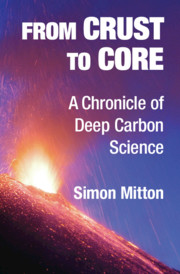Book contents
- From Crust to Core
- From Crust to Core
- Copyright page
- Dedication
- Contents
- Foreword
- Acknowledgments
- Introduction
- 1 Why Carbon in Earth Matters
- 2 The Origin of Deep Carbon in Deep Space
- 3 Deliveries of Cosmic Carbon Continue
- 4 On the Nature of Earth’s Interior
- 5 Earth’s Physical Interior Revealed
- 6 Thousands, Millions or Billions
- 7 Physics and Chemistry of Deep Earth
- 8 Confronting the Continental Drift Conundrum
- 9 The Mid-Atlantic Ridge and Rift Valley
- 10 Earth’s Deep Dynamics Discovered
- 11 Reversals of Fortune
- 12 Deep Carbon
- 13 Carbon-Bearing Phases in the Mantle
- 14 Diamond in the Mantle
- 15 Deep Life
- Glossary
- Biographical Notes
- Index
- References
15 - Deep Life
Published online by Cambridge University Press: 19 December 2020
- From Crust to Core
- From Crust to Core
- Copyright page
- Dedication
- Contents
- Foreword
- Acknowledgments
- Introduction
- 1 Why Carbon in Earth Matters
- 2 The Origin of Deep Carbon in Deep Space
- 3 Deliveries of Cosmic Carbon Continue
- 4 On the Nature of Earth’s Interior
- 5 Earth’s Physical Interior Revealed
- 6 Thousands, Millions or Billions
- 7 Physics and Chemistry of Deep Earth
- 8 Confronting the Continental Drift Conundrum
- 9 The Mid-Atlantic Ridge and Rift Valley
- 10 Earth’s Deep Dynamics Discovered
- 11 Reversals of Fortune
- 12 Deep Carbon
- 13 Carbon-Bearing Phases in the Mantle
- 14 Diamond in the Mantle
- 15 Deep Life
- Glossary
- Biographical Notes
- Index
- References
Summary
This chapter on deep carbon subsurface life opens at the 2018 Fall Meeting of the American Geophysical Union (AGU) in Washington, DC, where Deep Carbon Observatory (DCO) scientists showcased stupendous discoveries about deep life.1 Earth’s most pristine ecosystem, the deep biosphere, is home to members of all three domains of life: Archaea, Bacteria and Eukarya.2,3 Archaea and Bacteria are microbes, and the Eukarya include fungi, algae, unicellar organisms with organelles, as well as plants and animals. Unicellular organisms exist everywhere on Earth’s surface, from the thermophiles in the hot springs of Yellowstone National Park to the microbes living in your refrigerator or below the ice sheets of Siberia and Antarctica. The huge surprise that captivated the public following the press releases at AGU was the immense mass of carbon directly associated with subsurface bacterial life. Researchers estimated that this reservoir holds 15–23 billion tonnes of organic deep carbon.
- Type
- Chapter
- Information
- From Crust to CoreA Chronicle of Deep Carbon Science, pp. 303 - 332Publisher: Cambridge University PressPrint publication year: 2020

